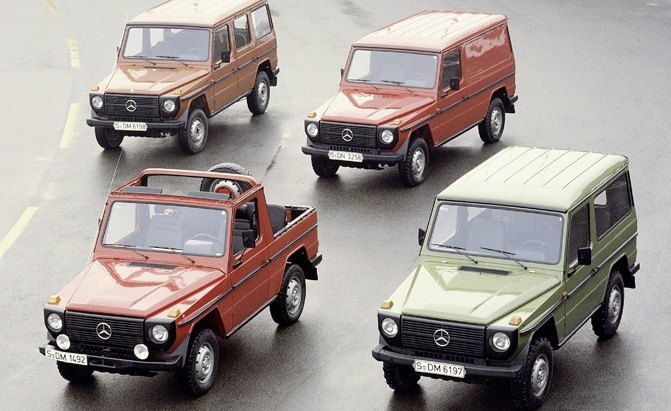The Road Travelled: History of the Mercedes-Benz G-Wagen
Contrary to popular belief, dinosaurs do still exist — and they’ve only grown mightier and more fierce as time goes on. At least that’s the case when examining the unusual Mercedes-Benz G-Class, a vehicle paleontologists might describe as the coelacanth of the SUV market.
Based on a prehistoric military design that was never actually intended to make it into civilian hands, the G-Class (or G-Wagen as it was known for much of its existence) has defied conventional wisdom to remain a popular touchstone for the German brand despite being remarkably out of step not just with the rest of the Mercedes-Benz showroom, but the entire automotive market.
Let’s look at how the Mercedes-Benz G-Class climbed out of the primordial ooze and hung around for 40 nearly years, making friends and building a reputation as being both an unstoppable off-road warrior and nouveau-riche fashion accessory.
1972-1979: Drafted!
Although it had almost always owned a thriving commercial truck division, Mercedes-Benz hadn’t considered building a sport-utility vehicle of any kind until a fateful phone call from one of the company’s shareholders, the Shah of Iran, put a bug in the corporate ear that maybe the Silver Star should be the company building the 20,000 light military transports that his country was poised to purchase. It was the early 1970s, and Mercedes-Benz, realizing that didn’t have the resources or expertise required to fill this massive order, contacted an Austrian manufacturer called Steyr-Daimler-Puch for the assist.
The vehicle was dubbed the Geländewagen, German for “cross-country vehicle,” and development proceeded along the function-over-form lines that one would expect from a military truck. Mercedes-Benz was very serious about making sure that the G-Wagen was more than capable of dealing with any terrain that could be thrown in front of it, and the truck featured solid axles front and rear with locking differentials, a part-time, low-range four-wheel drive system, and both short and long wheelbase editions depending on how many troops needed to ride along and how tight the trails might be. Testing included arctic and desert environments, and motivation was provided by a range of three gasoline and three diesel engines, with cylinder counts including four, five, and six depending on the model.
1979-1989: Split Personality
By the time the G-Wagen was ready for mass production in 1979, geopolitics had wiped out the Shah’s regime, leading Mercedes-Benz to seek out new markets for its go-anywhere SUV. While other nations stepped up to the plate and began to outfit their militaries with the truck, Daimler realized that a few rival automakers — such as Jeep with the Grand Wagoneer and Land Rover with the Range Rover — were beginning to tap into a higher class of customer for four-wheel-drive vehicles. Weighing a hefty 4,300 lbs, the G was split into two development branches — the army-oriented 461 and the civilian 460 — and sent marching out into the world.
Thus began the G-Wagen’s slow climb from troop carrier to Beverly Hills driveway bauble. The 460 narrowed maintained the full range of engine options, ranging from a 100-horsepower four-cylinder gas engine to a 150-horsepower straight six to a 3.0-liter six-cylinder diesel capable of 126 lb-ft of torque, while the military model offered one gas and two diesel choices. Four-door models were hardtops, but the two-door short-wheelbase G-Wagens could be had with a removable roof. Early trucks did little to disguise their battlefield roots, and it wasn’t until 1981 that the Geländewagen received niceties such as air conditioning and an automatic transmission. The cabin’s resolutely barebones appearance was gradually upgraded, too, but it took almost a decade before you could find things like power windows to go with its more bottom-friendly sedan-sourced seats and heating system.
ALSO SEE: Forget the ‘Ring, Watch Where the Mercedes G-Class Goes Testing
Throughout this period, the G-Wagen was never officially sold in the United States, but that didn’t stop enterprising importers from taking advantage of the vehicle’s grey market potential. Europa International was the most prominent party involved in bringing the Geländewagen across the ocean and modifying it to be road-legal in America, eventually working out a deal with the factory to have the necessary work done in Austria before importation began. Demand was huge ,and so were the prices: Europa International could command well into the six figures for the vehicle, which was several multiples of what it would cost to own an exotic European sports car of the same time period. It certainly didn’t hurt that the G-Wagen had won the grueling Paris to Dakar rally in 1983, further boosting its profile.
1990-1996: Luxury Awaits
Satisfied with their hoodwink arrangement in servicing American customers, Mercedes-Benz elected to keep the G-Wagen out of its U.S. dealerships for the 1990 model year but began to get serious about piling exactly the kind of luxury gear that was attracting deep-pocketed buyers. While the features that had seen more than 50,000 models sold so far to off-road adventurers were still being improved on — the Geländewagen gained a full-time four-wheel drive system that year, along with a trio of electronically locking differentials — street performance was also further tamed by way of anti-lock brakes. The G-Wagen’s interior environment, too, was plushed up with leather and wood trim, giving it for the first time some family resemblance with other Mercedes-Benz models once you opened the door.
ALSO SEE: Mercedes-AMG Turns 50: Highlights From a High-Performance History
Also helping were a number of chassis refinements to go with a limited-edition V8 model dubbed the 500 GE. Now bearing the 463 platform code, the 240 horsepower edition of the truck helped its massive bulk better keep up with modern traffic, although it would only be built for a handful of years, with the majority of G-Wagen sales remaining of the diesel variety.
1997-2004: Coming to America (For Real This Time)
By the end of the ’90s, Mercedes-Benz had finally come around to the idea of establishing a factory-backed Geländewagen beachhead in North America. Although a 215-horsepower V6 engine was added to the mix in 1997, it would be the return of the V8-powered (G500) model the following year with its 292 horses and 336 lb-ft of torque that would form the template for the U.S. G-Wagen, which would be renamed the G-Class when it was officially launched in 2002.
It was right around this period that in-house tuners AMG got involved with the Geländewagen/G-Class, a move that would dramatically expand the market for the off-roader. By adding serious horsepower to the now 5,000-plus pounder by way of a series of AMG engines (including a very low-production G63 AMG V12), the SUV finally had the drivetrain muscle to back up its brawny image. It was 2003’s G55 that would prove to be the most popular edition of the vehicle, first in naturally aspirated 5.5-liter V8 form (349 horsepower and 387 lb-ft of torque), and then in supercharged trim the following year (469 horses and 515 lb-ft of torque) to celebrate the vehicle’s 25th anniversary. The latter was capable of reaching 60 mph from a standing start in a mere 4.7 seconds.
2005-Present: The G-Class is Dead, Long Live the G-Class!
Mercedes-Benz made the decision to kill the Geländewagen not once, but twice over the course of the next dozen or so years. The first time was 2005, when it was felt that the G55 was a perfect sign-off for the North American market, and the company even went so far as to build 500 Grand Edition models of the truck intended to mark the end of exportation. The contract with the factory in Graz, Austria, was up for renewal, and Daimler wasn’t certain that the G-Class offered enough volume to keep moving forward. A flurry of orders, both military and civilian, granted the SUV a stay of execution, however, and it continued to garner significant street cred among Hollywood tastemakers, celebrities in general, and a host of aftermarket tuning companies including Brabus and Lorinser. Within a very short period of time, half of all G-Wagen orders were AMG editions.
Things stayed largely status quo in terms of G-Class development over the next five years or so, with the G55 and gaining incremental horsepower boosts that put it just over 500 horsepower before the end of the decade (the G500 would see its output also improve). Interior and exterior equipment also fleshed out to include a rearview camera, improved navigation, HID headlights, 19-inch rims, and even ventilated seats.
ALSO SEE: The Only 15 ‘Real’ SUVs Left on the Market
By 2010, the specter of the Graz contract ending once again put fear into the hearts of G-Class fans, but two subsequent renewals lead to a revitalization of the SUV’s drivetrain choices. For the 2013 model year, the new G550 would offer 388 horsepower and 391 lb-ft of torque from its 5.5-liter V8, while the G63 would replace the G55’s supercharged mill with a twin-turbo V8 good for 544 horses and 560 lb-ft of torque. This would be topped a few years later by the G65’s twin-turbo V12, which delivered 622 horsepower and 738 lb-ft of torque, and also added nearly 500 lbs to the vehicle’s curb weight, pushing it up past the 6,000-pound mark. Other recent G-Class models include a 6×6 version of the G65, as well as the G500 4X42, a portal axle off-road special.
See Also: 2019 Mercedes G Wagen Leaks ahead of Detroit Debut
Mercedes-Benz has promised a completely new version of the G-Class in the near future, one that will move away from its military roots and embrace the reality that the physics-defying AMG trucks have consistently chosen to ignore. 2018 has been pegged as the final model year for the traditional G-Class, giving the SUV almost 40 years of production on the same basic platform — a record unlikely to be broken by any future luxury automobiles.
More by Benjamin Hunting





































Comments
Join the conversation
Long live the G-Wagen